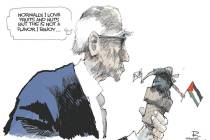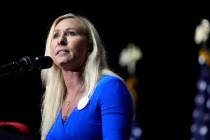Obamacare rate-hike bomb could explode in 2017
Nevadans are now knee deep in the Affordable Care Act’s second open enrollment period, which began Nov. 15 and closes Monday for coverage to take effect by Jan. 1. Many are finding what appears to be a pleasant surprise: Average premiums are increasing by only 4.9 percent. The Affordable Care Act’s naysayers predicted “double-digit” spikes or worse.
Those naysayers should have read the law more carefully. In Nevada, as elsewhere, average health care premiums are likely to modestly increase (and possibly decrease) both in 2015 and 2016. The real premium spikes won’t occur until January 2017—conveniently, after the next presidential election.
The Medical Industry Leadership Institute, where I am director, recently released an analysis predicting how the ACA will affect prices over the next few years. Using data provided by the Department of Health and Human Services, we estimated that single and family plan premiums in Nevada could increase by low single digits for 2015 — a prediction that has been largely borne out by the recently announced rates. As for 2016, we estimate that family and individual bronze plan premiums could change by 2 percent and minus-1 percent, respectively.
Up until that point, the Affordable Care Act will look little different from the system it replaced — a few percentage-point increases every year. True, it has not led to the dramatic cost savings that its authors promised, but neither has it made health care essentially unaffordable.
But 2017 will be the real test. The law contains two programs that will expire at the end of 2016: “Risk corridors” and “re-insurance.” Both programs conceal health insurance’s true costs — costs that truly have skyrocketed thanks to the ACA’s mandates and regulations.
Risk corridors and re-insurance operate in similar fashions. They subsidize insurance companies with taxpayer money. Risk corridors give insurance companies money if their customers spend more on health care than the insurer estimated; reinsurance allows insurance companies to bill the federal government for particularly expensive patients.
Both programs ultimately allow insurance companies to list artificially low premiums for their health care plans.
The Affordable Care Act’s authors created these two programs for a specific reason: They would ease the transition from the pre- to the post-ACA health care system. In the post-ACA world, health care is more expensive — a fact proved by 2014’s average 41 percent spike in base premiums. Reinsurance and risk corridors have largely hidden these price increases from consumers for the past year; they will continue to do so until Jan. 1, 2017.
Premiums will likely skyrocket come that date. The Medical Industry Leadership Institute’s study estimates that once the two subsidies expire, premiums for a cheap bronze plan in Nevada could increase by a staggering 96 percent for individuals and by 46 percent for families.
It appears that the law’s authors didn’t initially think this would be problematic; they assumed that the ACA would be so popular, or at least ingrained in the national psyche, that such changes would be taken in stride. Instead, recent polls show that the Affordable Care Act is more unpopular than ever.
The federal government will thus have to act to prevent yet another round of anti-ACA blowback. Washington has two options: extend the insurance company subsidies, or increase federal subsidy rates to match the rising premiums. Neither option seems politically feasible. Either or both would potentially add tens, perhaps hundreds, of billions of dollars to the annual federal deficit. And the Affordable Care Act was sold on the promise that it wouldn’t add, in President Barack Obama’s words, “a single dime” to those deficits.
Then again, that won’t actually be President Obama’s problem — voters in Nevada and across America will already have chosen his successor once this crisis becomes apparent. But no matter who addresses it and how, one thing is certain: The debate about the Affordable Care Act is nowhere close to ending.
Stephen T. Parente is a professor of health finance and associate dean of the Carlson School of Management, and director of the Medical Industry Leadership Institute at the University of Minnesota.























